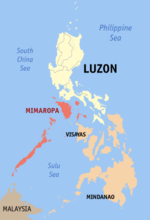Sablayan
Sablayan | |
|---|---|
 | |
 Map of Occidental Mindoro showing the location of Sablayan | |
| Country | Philippines |
| Region | MIMAROPA (Region IV-B) |
| Province | Occidental Mindoro |
| District | Lone District of Occidental Mindoro |
| Founded | 1906 |
| Barangays | 22 |
| Government | |
| • Mayor | Eduardo B. Gadiano |
| Area | |
• Total | 2,188.80 km2 (845.10 sq mi) |
| Population (2010)[3] | |
• Total | 76,153 |
| • Density | 35/km2 (90/sq mi) |
| Time zone | UTC+8 (PST) |
| ZIP code | 5104 |
| Dialing code | 43 |
| Income class | 1st Class; Partially Urban |
Sablayan (Tagalog pronunciation: [sɐblajan])is a first class municipality in the province of Occidental Mindoro, Philippines. According to the 2010 census, it has a population of 76,153 people.[3]
It has a total land area of 2,188.80 square kilometers,[2] making it the largest municipality in the Philippines. The Apo Reef, North and South Pandan Islands, and a portion of Mounts Iglit-Baco National Park are part of its jurisdiction.
Geography
Sablayan is located in the central part of Occidental Mindoro. It is bounded to the north by the municipality of Santa Cruz and the municipalities of Baco, Naujan, Victoria and Socorro all in Oriental Mindoro province; to the east by the municipalities of Pinamalayan, Gloria, Bansud, Bongabong and Mansalay also in Oriental Mindoro; to the south by the municipality of Calintaan; and to the west by the Mindoro Strait.
Barangays
Sablayan is politically subdivided into 22 barangays.[2] In 1957 the following barrios were renamed: Batasan to Claudio Salgado, Hinaya to Buhay na Bato (Batong Buhay) and Iriron to San Isidro.[4]
- Batong Buhay
- Buenavista (town proper)
- Burgos
- Claudio Salgado
- General Emilio Aguinaldo
- Ibud
- Ilvita
- Ligaya
- Poblacion (Lumangbayan)
- Paetan
- Pag-Asa
- San Agustin
- San Francisco
- San Nicolas
- San Vicente
- Santa Lucia
- Santo Niño
- Tagumpay
- Victoria
- Lagnas
- Malisbong
- Tuban
History

The town used to be called Dongon, a coastal village located currently at Brgy. San Nicolas. The first accounts of the baptism of the locals under the Recollects were recorded in 1670. By 1749, Dongon became the biggest pueblo in the whole island of Mindoro in terms of population.
In 1754, the Moro pirates started attacking the town, and almost every year thereafter, until in 1791 when the Moros effectively wiped out the whole population from more than 600 inhabitants to less than 98 souls.
In 1814, the inhabitants of Dongon gradually transferred to the village of Sablayan, until Dongon ceased to become a village in 1829.[5] In 1832, the missionary friar Simeon Mendoza de la V. de Ibernalo[6] requested the Spanish government for the exemption of the town's inhabitants from paying taxes so that they could build a stone church, convent and fort at a hilly part of the village. The church that stands today at the town may have been built from 1832-1835, and its advocacy was placed under San Sebastian.
Demographics
| Year | Pop. | ±% p.a. |
|---|---|---|
| 1990 | 46,546 | — |
| 1995 | 55,573 | +3.38% |
| 2000 | 63,685 | +2.96% |
| 2007 | 70,506 | +1.41% |
| 2010 | 76,153 | +2.84% |
| Source: National Statistics Office[3] | ||
List of former mayors
Culture
Held once a year the Dugoy Festival is a celebration of the Mangyan culture.
References
- ^ "Official City/Municipal 2013 Election Results". Intramuros, Manila, Philippines: Commission on Elections (COMELEC). 11 September 2013. Retrieved 23 December 2013.
- ^ a b c "Province: OCCIDENTAL MINDORO". PSGC Interactive. Makati City, Philippines: National Statistical Coordination Board. Retrieved 1 November 2012.
- ^ a b c "Total Population by Province, City, Municipality and Barangay: as of May 1, 2010" (PDF). 2010 Census of Population and Housing. National Statistics Office. Retrieved 1 November 2012.
- ^ "An Act Changing the Names of Certain Barrios in the Municipality of Sablayan, Province of Occidental Mindoro". LawPH.com. Retrieved 2011-04-12.
- ^ Candelario, Rudy. "History of the Town of Sablayan". https://sites.google.com/site/occidentalmindorohistory/histroysablayan.
{{cite web}}: External link in|website= - ^ Provincia de San Nicolas de Tolentino de Agustinos Descalzos de la Congregacion de España e Indias. Manila: Imprenta del Colegio de Santo Tomas. 1879. pp. 118–119.

